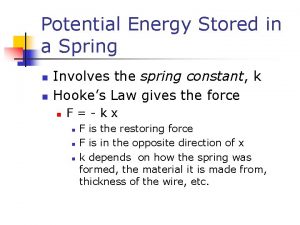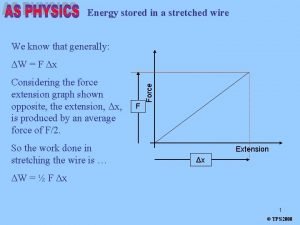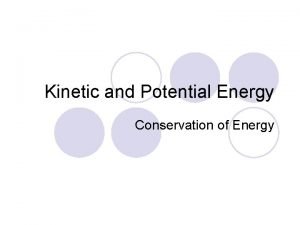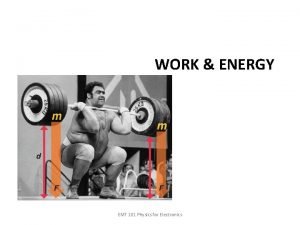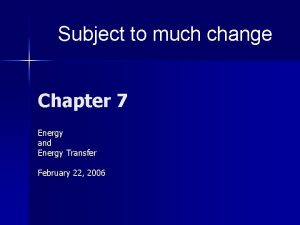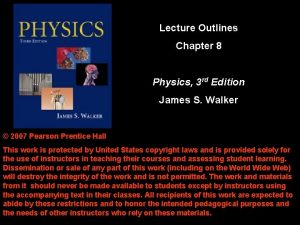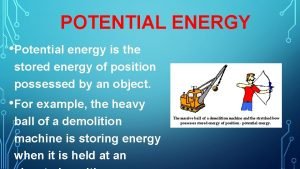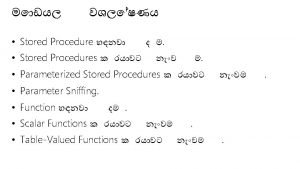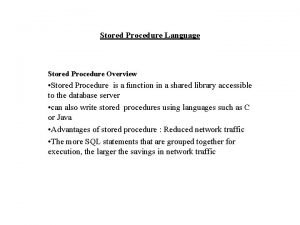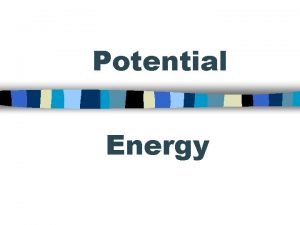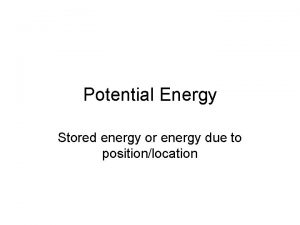Potential Energy Stored in a Spring n n


















- Slides: 18

Potential Energy Stored in a Spring n n Involves the spring constant, k Hooke’s Law gives the force n F=-kx n n n F is the restoring force F is in the opposite direction of x k depends on how the spring was formed, the material it is made from, thickness of the wire, etc.

Potential Energy in a Spring n Elastic Potential Energy n n related to the work required to compress a spring from its equilibrium position to some final, arbitrary, position x

Work-Energy Theorem Including a Spring n Wnc = (KEf – KEi) + (PEgf – PEgi) + (PEsf – PEsi) n n n PEg is the gravitational potential energy PEs is the elastic potential energy associated with a spring PE will now be used to denote the total potential energy of the system

Conservation of Energy Including a Spring n The PE of the spring is added to both sides of the conservation of energy equation n n The same problem-solving strategies apply

Nonconservative Forces with Energy Considerations n n When nonconservative forces are present, the total mechanical energy of the system is not constant The work done by all nonconservative forces acting on parts of a system equals the change in the mechanical energy of the system n

Nonconservative Forces and Energy n n In equation form: The energy can either cross a boundary or the energy is transformed into a form of non-mechanical energy such as thermal energy

Transferring Energy n By Work n n By applying a force Produces a displacement of the system

Transferring Energy n Heat n n The process of transferring heat by collisions between molecules For example, the spoon becomes hot because some of the KE of the molecules in the coffee is transferred to the molecules of the spoon as internal energy

Transferring Energy n Mechanical Waves n n A disturbance propagates through a medium Examples include sound, water, seismic

Transferring Energy n Electrical transmission n n Transfer by means of electrical current This is how energy enters any electrical device

Transferring Energy n Electromagnetic radiation n Any form of electromagnetic waves n Light, microwaves, radio waves

Notes About Conservation of Energy n We can neither create nor destroy energy n n n Another way of saying energy is conserved If the total energy of the system does not remain constant, the energy must have crossed the boundary by some mechanism Applies to areas other than physics

Power n n Often also interested in the rate at which the energy transfer takes place Power is defined as this rate of energy transfer n n SI units are Watts (W) n

Power, cont. n US Customary units are generally hp n n Need a conversion factor Can define units of work or energy in terms of units of power: n n kilowatt hours (k. Wh) are often used in electric bills This is a unit of energy, not power

Center of Mass n The point in the body at which all the mass may be considered to be concentrated n When using mechanical energy, the change in potential energy is related to the change in height of the center of mass

Work Done by Varying Forces n The work done by a variable force acting on an object that undergoes a displacement is equal to the area under the graph of F versus x

Spring Example n Spring is slowly stretched from 0 to xmax n n W = ½kx²

Spring Example, cont. n n n The work is also equal to the area under the curve In this case, the “curve” is a triangle A = ½ B h gives W = ½ k x 2
 Energy stored in a spring
Energy stored in a spring Elastic potential energy stored in a stretched wire
Elastic potential energy stored in a stretched wire Stored subprogram adalah
Stored subprogram adalah Friction energy
Friction energy Gpe meaning
Gpe meaning The change in mechanical energy
The change in mechanical energy Spring potential energy formula
Spring potential energy formula Power formula
Power formula Gravitational potential energy
Gravitational potential energy Potential energy spring
Potential energy spring Electrostatic potential difference
Electrostatic potential difference Electrical potential energy
Electrical potential energy V=pe/q
V=pe/q Energy equation
Energy equation Gravitational
Gravitational Potential energy to chemical energy examples
Potential energy to chemical energy examples Uses of mechanical energy
Uses of mechanical energy Gravitational potential energy vs kinetic energy
Gravitational potential energy vs kinetic energy Kinetic energy vs potential energy
Kinetic energy vs potential energy
